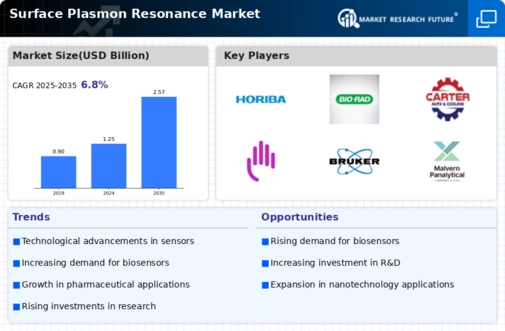Market Trends
Key Emerging Trends in the Surface Plasmon Resonance Market
The surface plasmon resonance (SPR) market is experiencing significant trends influenced by various factors impacting both supply and demand dynamics. One notable trend is the increasing adoption of SPR technology in drug discovery and development processes. SPR technology enables real-time monitoring of biomolecular interactions, making it a valuable tool for studying protein-protein interactions, receptor-ligand binding, and drug-target interactions. This trend is driven by the growing demand for high-throughput screening methods and advanced analytical techniques in pharmaceutical research, as well as the need for more efficient and cost-effective approaches to drug discovery and development. As a result, there is a rising demand for SPR instruments and consumables that offer improved sensitivity, throughput, and data analysis capabilities, driving growth in the drug discovery and life sciences segments of the market.
Another prominent trend in the SPR market is the expanding applications in academic research and clinical diagnostics. SPR technology is increasingly being used in academic and research institutions for studying fundamental biological processes, biomarker discovery, and disease diagnostics. Additionally, SPR-based biosensors are gaining traction in clinical diagnostics for detecting and quantifying biomolecules such as proteins, antibodies, nucleic acids, and small molecules in biological samples. This trend is driven by the need for more sensitive, specific, and rapid diagnostic methods in healthcare, as well as the growing interest in personalized medicine and point-of-care testing. As a result, there is a rising demand for SPR systems and assay kits that offer high sensitivity, multiplexing capabilities, and automation features, driving growth in the academic research and clinical diagnostics segments of the market.
Furthermore, the market is witnessing technological advancements and product innovations aimed at improving the performance and versatility of SPR systems. Manufacturers are investing in research and development to develop next-generation SPR instruments with enhanced sensitivity, resolution, and throughput, as well as advanced data analysis software and automation features. Additionally, there is a growing demand for integrated SPR platforms that combine SPR technology with other analytical techniques such as mass spectrometry, microfluidics, and imaging, enabling multi-modal analysis of biomolecular interactions and cellular processes. This trend is driven by the need for more comprehensive and holistic approaches to biomedical research and diagnostics, as well as the increasing complexity of biological systems and samples.
The SPR market is also influenced by regulatory factors and quality assurance requirements impacting product development and commercialization. Regulations governing the use of SPR technology in drug discovery, clinical diagnostics, and biomedical research can affect market dynamics and product validation strategies. Additionally, quality assurance standards and regulatory compliance requirements for manufacturing processes, assay development, and data analysis can impact the time-to-market and commercialization strategies of SPR products. This trend is prompting manufacturers to invest in regulatory affairs, quality management systems, and product validation studies to ensure compliance with relevant standards and regulations, as well as to enhance the credibility and reliability of SPR-based assays and systems.
Moreover, the market is experiencing increased competition and market consolidation among key players, leading to strategic partnerships, mergers, and acquisitions to strengthen market positions and expand product portfolios. As the industry becomes more consolidated, companies are focusing on innovation, efficiency, and market expansion to maintain competitiveness and drive growth. This trend is driving investments in research and development, as well as market expansion strategies to tap into emerging markets and untapped opportunities in the SPR market.
On the supply side, the SPR market is influenced by factors such as raw material availability, manufacturing capacity, and technological advancements. Fluctuations in the availability and pricing of raw materials such as gold nanoparticles, sensor chips, and reagents can impact market dynamics and pricing. Additionally, advancements in manufacturing technologies and process optimization are improving the efficiency and cost-effectiveness of SPR instrument production, driving supply growth and market competitiveness.


















Leave a Comment